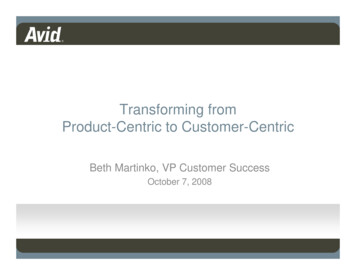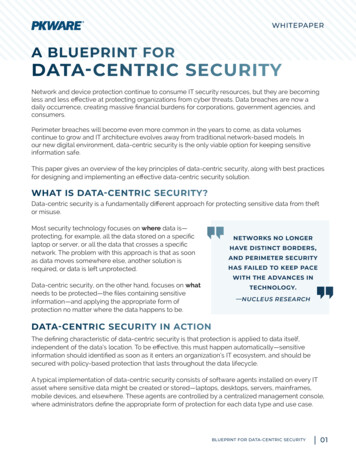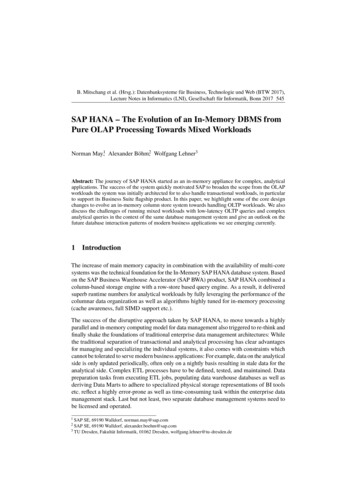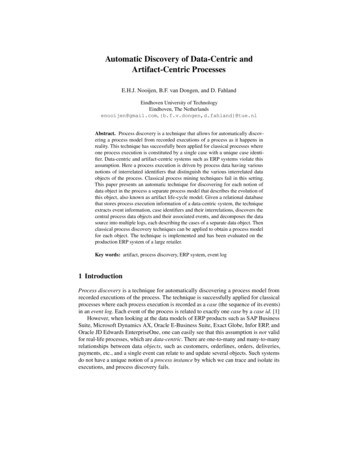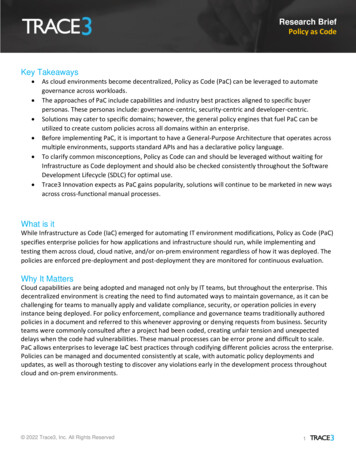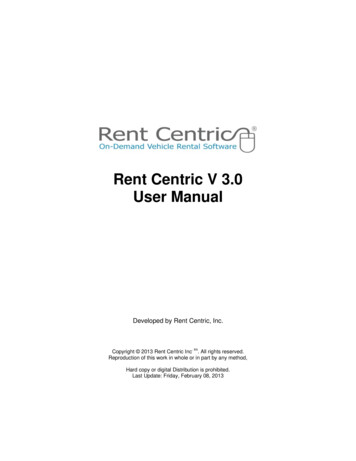
Transcription
A data-centric approach to digital transformation ofhealthcare and clinical researchPatrik Georgii-Hemming, MSci, MD, PhDCMIOKarolinska University Hospital
Clinicians, clinical researchers & scientistsmake decisions based on data so we need a data-centric approach to ITdevelopment
What is wrong with how we usually create software today?Most organisations have appliosclerosis!The application-centric approach starts with“what does this system need to do?”. Data issecondary.The data-centric approach puts data at thecenter of the enterprise. Applications areoptional visitors to the data.Reasonable cost of changeData is an open resource that outlives any given applicationNew projects taps into existing data storesData is globally integrated sharing a common meaning, being exportedfrom a common source into any needed formatData integration will be nearly freeInternal and external data readily integrated 3 Exorbitant, often prohibitive, cost of changeData is tied up in applications because applications own dataNew projects come with a big data conversion projectData exists in wide variety of heterogeneous formats, structures,meaning, and terminologyData integration consumes 35%-65% of IT budgetHard or impossible to integrate external data with internal data
So, how did we end up here?Both providers and vendors drive this focus onbehavior so it is hard to meet new requirements 1. Modify existing applicationsProcurementsand new development are driven byrequirements onbehavior (almostexclusively)Expensive, ’one-size-fits-all’ Expensive, limited Expensive integrationsSilos2. Provide APIs to enablethird-party developmentHealthcare/life science data iscomplex and we have so farlargely failed to converge towardcommon standards4 3. Buy/build a new application
A data-centric platform based on openEHRA fragmentedIT-environmentcomplicatescollaborationin the clinicalprocessIt is difficult to keepup with new andchanging requirementsHigh-quality data at pointof care*Agile and sustainabledevelopmentopenEHRA fragmentedIT-environmentcomplicates secondaryuse of data in qualityimprovement andresearch5High-quality data forquality improvementand clinical research* We don’t think best-of-suite is a good solution for many reasonsbut that is a topic for another presentation
Data-driven healthcareSymptom1. DataInvestigation3. ProcessTreatmentplanEffective ways toregister dataPROM/PREMCare documentationPathology reportingRadiology reporting.and much more 2. KnowledgeDiagnosisAccess toguidelines &CDSSTreatmentRight information, to the right people, in the right formats,through the right channels, at the right timesCreatesinformationUsesinformation RequiresPatient overviewsQuality reportingResearchRight investigationRight diagnosisRätt treatmentRight follow-upSupporting care continuityCase managementClinical pathways6Follow up
Data – how we use standards in the data life cycle“Gartner believes that truly effective and sustainableopen architectures will need a capability for vendorneutral data persistence, such as utilizing a commonschema or set of openEHR archetypes and rules formanaging structured and unstructured data (forexample, a VNA, openEHR or IHE XDS repository incombination with services for trust/consent, ecosystemgovernance and oversight, and reuse of data andprocesses for secondary purposes, such as researchand population health).Providing open messaging standards (for example,FHIR, HL7) for data exchange in specific use cases willonly go so far in meeting the architectural challengesof digital citizen-centric care delivery”Healthcare Provider CIOs Need to Rally Their EnterpriseArchitects Around Citizen-Centric Care Delivery, Gartner 20177
Data – using openEHR to improve data quality in HIS“In attempting to arrive at the truth,I have applied everywhere for information,but in scarcely an instance have I been able toobtain hospital records fit for any purposes ofcomparison. If they could be obtained, they wouldenable us to decide many other questions besidesthe ones alluded to”Florence Nightingale, Notes on a hospital, 1873Bruland et al. BMC Medical Research Methodology (2016) 16:159RWD is not fit-for-purpose in many cases!8
Three solution patterns – correct data quality problemsat the source!12Using openEHRtemplates whenconfiguringdata input screensEmbeddopenEHRbased formETLopenEHRCDRQuality improvement & clinical research incollaboration with partners93Build apps onopenEHR basedplatformwritebackopenEHRCDRopenEHRCDRInternal needs at Karolinska
Data - using openEHR to improve data quality in existing HISNeedsTakeCareanalysisUse casespecifictemplatesSemantics is keptintactConfiguration of input forms in EHR systems using spreadsheets, openEHR archetypes and templates. Sundvall, Terner, Broberg & Gillespie. Medinfo 2019 proceedings, pages 1781-1782 http://dx.doi.org/10.3233/SHTI190645
Knowledge - development of simple decision ellingNeeds assessmentThe clinical needs aredocumented andstakeholders are identified11Archetypes, templates,rules and guidelines aremodeled and verified withcliniciansValidationForm buildingDecision support, formsand applications aredeveloped and verifiedwith clinicians andstakeholdersProvisioning/embeddingThe application isembedded in GUI andlinked (R/W) with EHRData is stored in CDR andmade accessible with API:s
openEHR ecosystemClinical involvementReuse!Tooling to support nocode/low-code and tradapp devForm tool, form rendering,AQL editor, rule engine, agementCKM (clinical knowledgemanager)12openEHR based platformCDR and services (IAM etc)Data can be persisted indifferent ways depending onneed
Summary We need a data-centric approach openEHR is focused on building a data-centric platform We see a lot of interest in using FHIR for C2B applications based on legacy systems We are testing FHIR in B2B applications but the critical mass is not there yet for us Data quality issues should be addressed at the source, mapping is not enough openEHR has solved the ”curly braces problem” by developing AQL and GDL(but with also use CDS-hooks to integrate CDSS with non-openEHR solutions)13
The application-centric approach starts with "what does this system need to do?". Data is secondary. The data-centric approach puts data at the center of the enterprise. Applications are optional visitors to the data. Exorbitant, often prohibitive, cost of change Data is tied up in applications because applications own data
